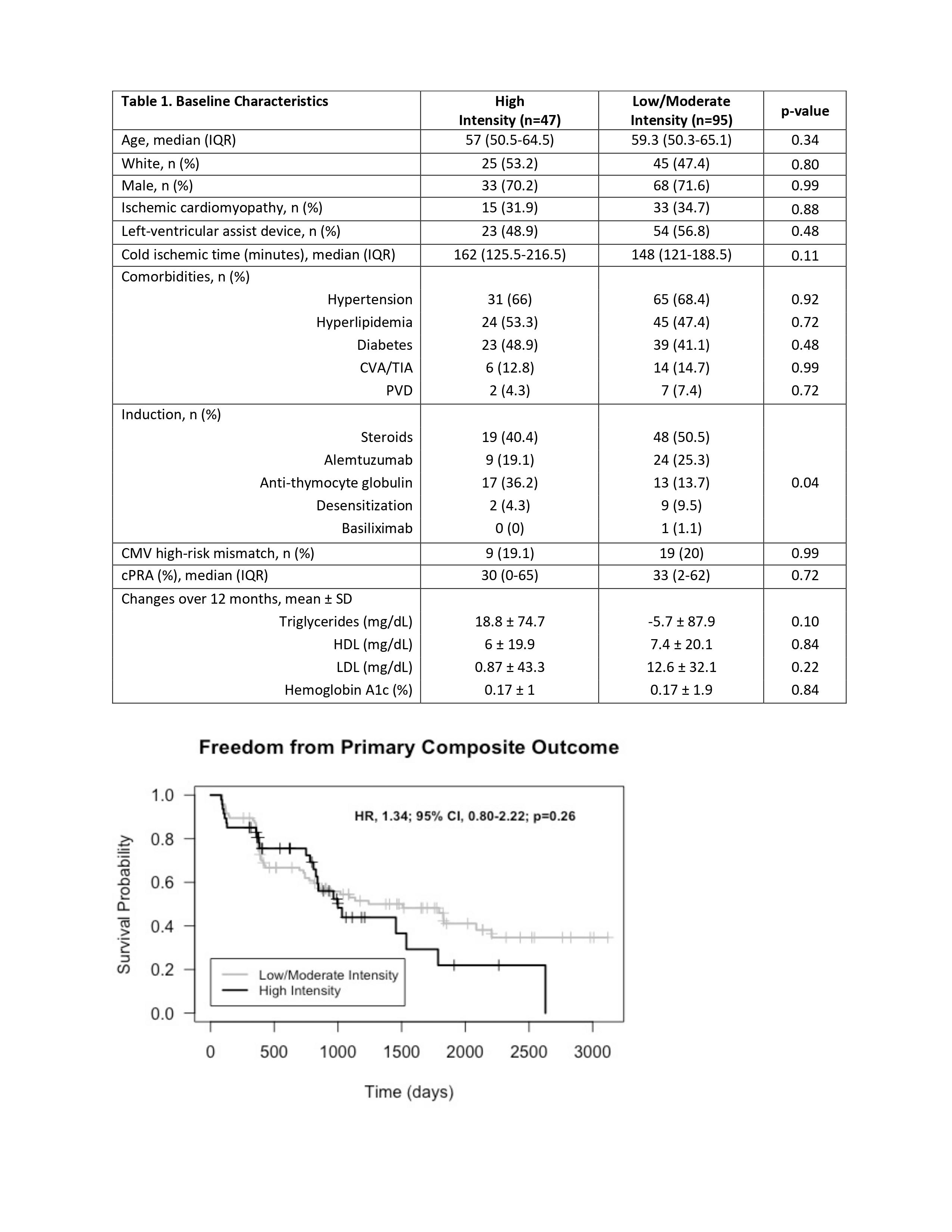Impact of Statin Intensity on the Incidence of Vascular Events and Graft Survival in Heart Transplant Recipients
1University of Maryland School of Pharmacy, Baltimore, MD, 2Pharmacy, University of Maryland Medical Center, Baltimore, MD, 3University of Maryland School of Medicine, Baltimore, MD
Meeting: 2021 American Transplant Congress
Abstract number: 146
Keywords: Graft survival, Heart transplant patients, HMG-CoA reductase inhibitor, Vascular disease
Topic: Clinical Science » Heart » Heart and VADs: All Topics
Session Information
Session Name: Do's and Don'ts of Heart Transplant Care
Session Type: Rapid Fire Oral Abstract
Date: Sunday, June 6, 2021
Session Time: 4:30pm-5:30pm
 Presentation Time: 4:50pm-4:55pm
Presentation Time: 4:50pm-4:55pm
Location: Virtual
*Purpose: Cardiac allograft vasculopathy (CAV) limits long-term graft survival of heart transplant (HT) recipients. In addition to decreased synthesis of cholesterol, statins also demonstrate immunomodulatory effects and slow progression of CAV. Few studies have assessed the effects of statin potency on long-term graft outcomes.
*Methods: This single-center, retrospective, cohort study included HT recipients from 2012-2020 who were started on high-intensity statins and compared them to those started on low/moderate-intensity statins within the first six months of HT. The primary endpoint was freedom from a composite of ISHLT CAV1-3, need for percutaneous coronary intervention (PCI), graft loss, or death. Secondary endpoints included each component of the composite endpoint. Cox proportional hazards models were used for primary and secondary outcomes, and event curves were generated using the Kaplan-Meier method. Metabolic parameters were assessed using repeated measures ANOVA.
*Results: Of 142 patients included, 47 received high-intensity and 95 received low/moderate-intensity statins within six months of HT. Mean follow-up was longer in the low/moderate-intensity cohort (4.4 ± 2.2 vs. 3.1 ± 1.9 years; p=0.0008). Baseline characteristics were similar between groups, aside from induction therapy and baseline triglycerides (Table 1). Aspirin use was common (97.9% high-intensity vs. 96.8% low/moderate-intensity; p=0.99); Sirolimus conversion was similar between groups (38.3% high-intensity vs. 34.7% low/moderate-intensity; p=0.82). There was no significant difference in the primary outcome (HR, 1.34; 95% CI, 0.80-2.22; p=0.26), even after controlling for induction therapy and pre-transplant hyperlipidemia. There were no significant differences in any of the secondary outcomes. After 12 months of follow-up, low-density lipoprotein marginally increased in the low/moderate-intensity cohort (0.87 ± 43.3 mg/dL high-intensity vs. 12.6 ± 32.1 mg/dL low/moderate-intensity; p=0.22).
*Conclusions: This study suggests that early initiation of high-intensity statins provides no benefit in the prevention of long-term adverse vascular and graft outcomes compared to low/moderate-intensity statins. Given their increased propensity for adverse effects (e.g., myalgias), high-intensity statins may better serve HT recipients with refractory post-HT hyperlipidemia.
To cite this abstract in AMA style:
Kim E, Booth I, Madathil R, Ravichandran B, Demehin M, Plazak M. Impact of Statin Intensity on the Incidence of Vascular Events and Graft Survival in Heart Transplant Recipients [abstract]. Am J Transplant. 2021; 21 (suppl 3). https://atcmeetingabstracts.com/abstract/impact-of-statin-intensity-on-the-incidence-of-vascular-events-and-graft-survival-in-heart-transplant-recipients/. Accessed January 7, 2026.« Back to 2021 American Transplant Congress

